To Michael Faraday and James Clerk Maxwell
/There is no better way to finish the first year of conversations on relativity and electromagnetic topics than to talk of the contribution of Michael Faraday and James Clerk Maxwell to the study of electricity and magnetism. The Royal Institution of Great Britain in Albemarle Street in London has an Electrical and Magnetic Museum devoted to Michael Faraday. Faraday performed his investigations at the Royal Institution and his original equipment is on display. Faraday's lines of electric and magnetic force permeate the thinking of physicists and electrical engineers. While at nearby King's College James Clerk Maxwell used Faraday's lines of force in his Dynamical Theory of the Electromagnetic Field, published 150 years ago. Maxwell's four equations, and their solutions, give us a complete description of the electromagnetic field. As an example, imagine that in a rectangular region of space an electric field E exists whose x-component is constant and whose y-component is proportional to the x coordinate. Many physics and engineering students do not realise that a perpendicular time varying magnetic field B must accompany this E field. Why?
